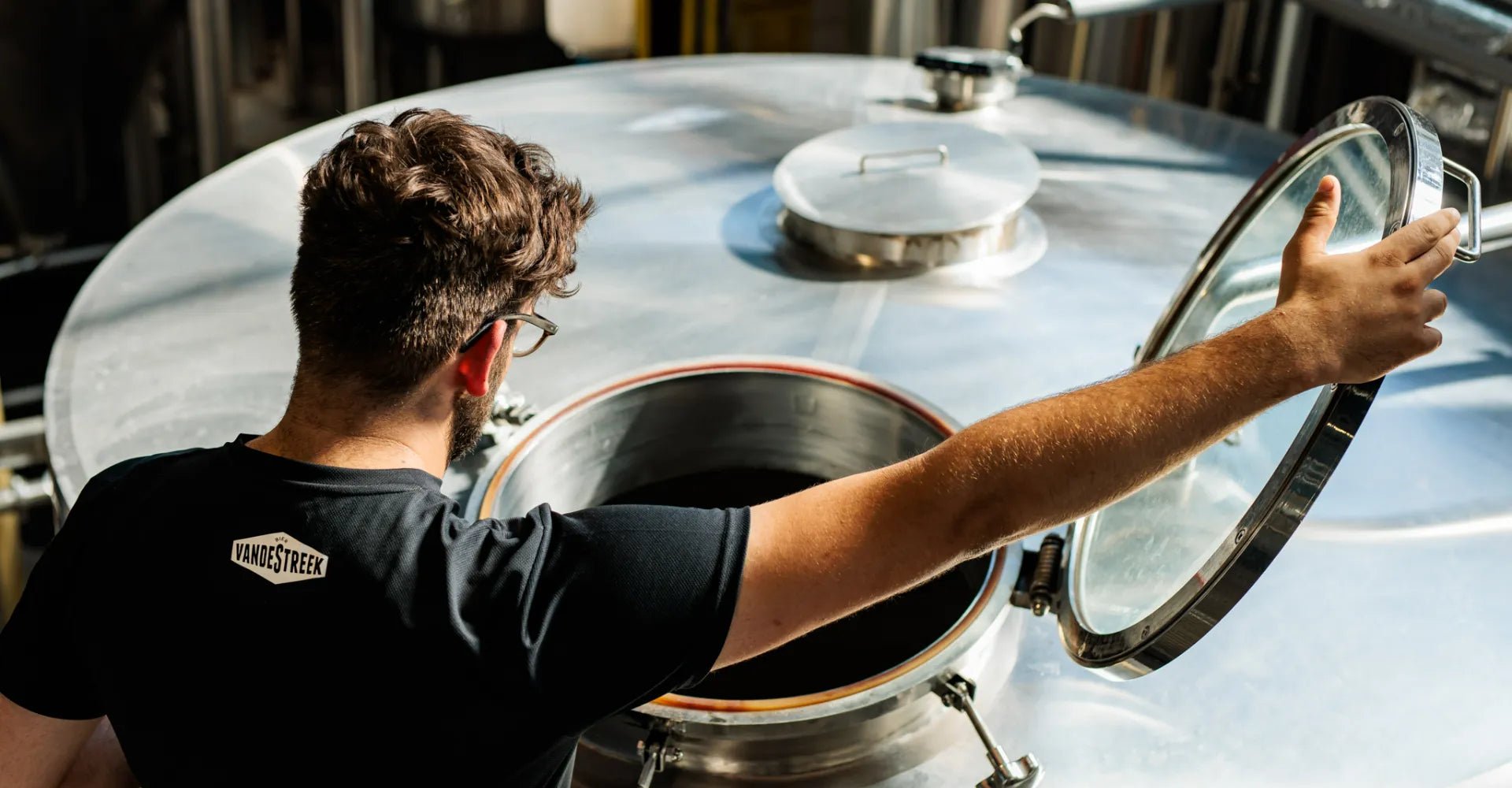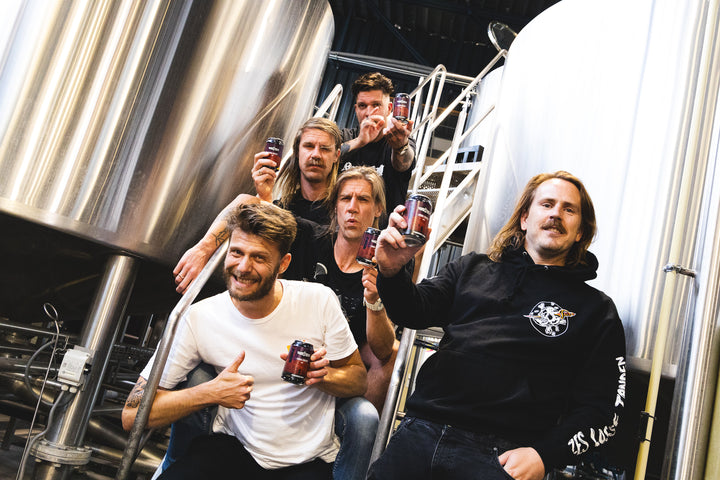- News
- /
How is beer brewed?

We brew beers packed with flavours every day with just four simple ingredients: water, malt, hops, and yeast. So, what exactly is involved in that brewing process? What steps do we take to ensure that you can enjoy a delicious glass of beer?
The recipe
As with everything, the whole process starts with an idea. This could be an idea about what we fancy brewing or what is still missing from our fridge. Once we have an idea, Ronald, Sander, and our brewers start working on a recipe. These recipes are relatively similar to those in a cookery book. They determine the types and quantities of malts, hops, and yeast to be used. Besides ingredients, beer recipes also contain process descriptions, such as temperatures, pH values, and amounts of CO2. So, when we brew a nice full-bodied NEIPA, we add oats and wheat to the malt mix. And for a tasty bitterness, we add more hops to the kettle.
Besides the ingredients, we also make choices about the process itself. The brewing times can be adjusted, temperatures fine-tuned, and steps lengthened or shortened to get the best and tastiest results.

Crushing
Once we have the recipe sorted out, we start brewing. Our brewing day begins with crushing the malt. One of the brewers empties the bags of malt into the malt mill, where the malt is ground into coarse pieces. We use the entire grain, i.e. both the grain itself and the chaff. The chaff will come in handy later in the process. After crushing, the crushed malt is transported through a tube to the brew house, where it goes into the next step of the process.

Mashing
The crushed malt ends up in the mashing kettle, the first kettle of the brew house. This kettle is full of hot water, where the starch from the malt is converted into sugars. This is accomplished by certain enzymes from the malt being activated by the hot water. After a while, the result of the enzymes’ work is a kettle full of grain mash. We then heat this mash to 80°C, which causes the enzymes to stop working, after which it can go to the next kettle.

Filtering
The mash arrives in the filtration tank. The filtration tank has a double bottom that serves as a sieve. The clear liquid - the wort - flows to the next kettle, while the chaff is left in the double bottom. This causes the chaff to form another filter, thereby filtering the wort even better. We also add more water during this process to ensure all sugars are flushed out of the malt and taken to the following process.
The residue left in the filter tank after this process is called spent grain. Spent grain consists of the chaff and solid malt particles from which almost all sugars have been extracted. You can do all kinds of things with spent grain. You can use it to bake bread or as compost in your garden. We send our spent grain to Farmer Jan, who feeds it to his goats. The milk these goats produce is then used to make cheese, which you can enjoy in our sampling rooms!

Boiling
We then start boiling the wort in another kettle. Any unwanted aromas evaporate during boiling, proteins clump together, and the liquid becomes sterile. This is the moment when hops first appear on the scene. By adding hops to the kettle, the final beer will have a delicate bitterness.

Whirlpool
By adding hops during boiling, the beer will again contain some solids. You don’t want these in your beer, so this has to be separated. This happens in the whirlpool. We introduce the wort into this tank at an angle, creating a centrifugal force that causes all solids to accumulate in the centre of the tank. You can recreate this effect at home by vigorously stirring a glass of loose tea. Once all solids have pooled in the centre of the tank, we move the clear wort to the next step.
Cooling
Before the wort we have now can become beer, it must be cooled. The temperature to which it is cooled depends on the type of beer that will eventually have to come out of the tank. For lagers (bottom-fermenting beers), this is 10 to 15°C. Top-fermented beers are cooled to a temperature between 18 and 24°C. We collect the water used for cooling in the hot water tank. We can use this water later as mashing-in liquor for the next brew.
Fermentation
After cooling, the wort goes to the fermentation tank. This is where we introduce the yeast to the wort. We already decided which yeast strain to use and at what temperature to ferment when we created the recipe. After the fermentation temperature is set, the yeast gets to work. During this process, the yeast feeds on all the sugars in the wort and converts them into alcohol and carbon dioxide. Depending on the yeast strain, the yeast also creates different flavours and aromas in the beer. After about a week, the yeast will have done its job, and we cool it all down to 2°C. We do this with all our beers, regardless of whether they are high in alcohol or contain no or almost no alcohol.
IPAs and other hoppy beers are also dry-hopped during fermentation. We add hops to the fermenting beer at this point to allow extra flavour and aroma from the hops into the beer.

Lagering
Maturing beer in a tank is called lagering. We do this at 2°C. Any unwanted particles that have formed during fermentation are eliminated during lagering. They either dissipate or are cleared by the yeast. During this cold maturation process, the proteins, yeast, and hops will sink to the bottom of the tank.
Centrifuge
After lagering, we get the beer ready for filling. All our beers go through a centrifuge, also called a separator, to ensure you will not get any bits in your beer. During this process, all liquids, such as hop oils, will remain in the beer, and all the solid bits will be flung out of the beer by a strong centrifugal force. By letting the beer to go through this process faster or slower, we ensure consistent clarity or cloudiness in the beers. Essentially, all beers go through this process. Even beers like Hazy Weekend and Frisky! Our lager is the only beer that undergoes additional filtration after centrifugation to make it crisp and clear.
Bottling
The final step before you can start enjoying our beer is to fill it in cans, kegs, or bottles. During the filling process, it is essential that as little oxygen as possible gets to the beer. That is why we first fill the cans, kegs, or bottles with CO2 before filling them with beer. This ensures that as little oxygen as possible remains in the packaging and that the beer keeps longer.
Beer hates air and light. Once beer has been exposed to these two elements, its quality deteriorates much faster. This is one of the reasons why we fill almost all our beers in cans. Cans do not allow light to reach the beer, and the headspace, the empty space at the top of the container, is minimal and well-oxygenated. Besides, cans chill faster, take up less space in your fridge, and are more efficient to transport. If you want to the best beer experience, you should go for keg beer. This is the very best packaging for beer.
To enjoy our keg beers, you can visit our sampling rooms or any of the licensed premises serving our beers. Alternatively, you can hire your own tap from us. Send an email to bestelling@vandestreek-bier.nl with your request, and we will see if a tap is available!

Enjoy!
And that brings us to the best moment of the brewing process - enjoying the result! We have taken you through all the stages of the brewing process, from individual ingredients to a delicious beer. We happen to love brewing, with the brewery as our playground. Exploring new flavours and techniques and brewing the tastiest beers is our passion, and we are nowhere near finished with it. Cheers!

